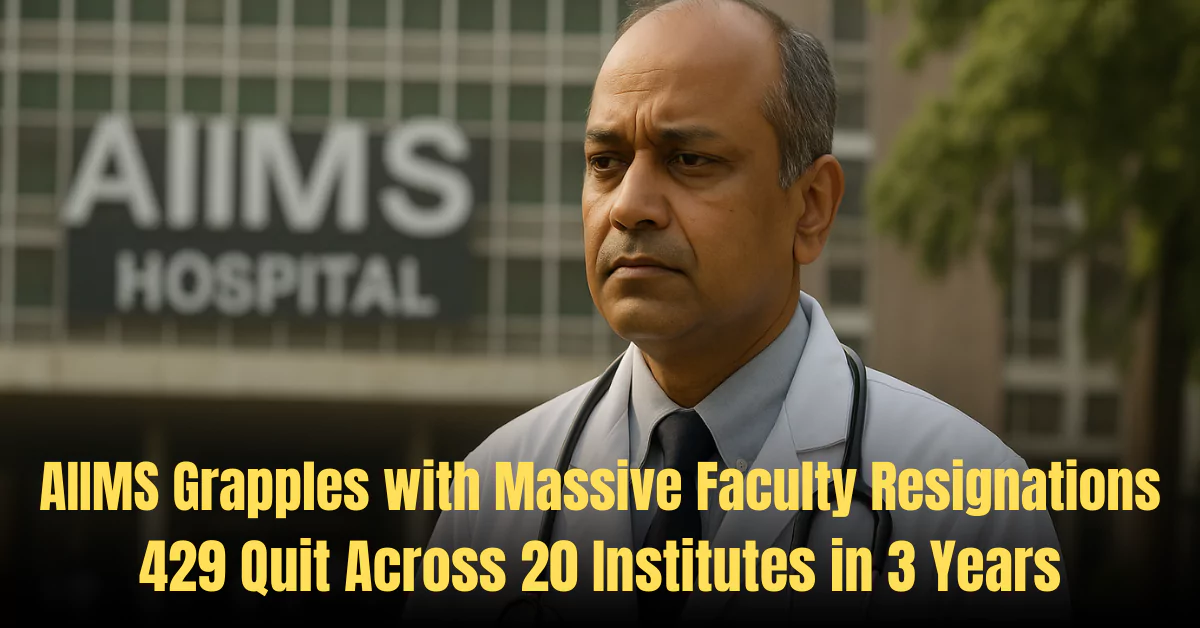AIIMS Faculty Crisis: The government recently disclosed in the parliament that 429 faculty members resigned from various All India Institutes of Medical Sciences (AIIMS) between 2022 and 2024. Among these, 52 resignations came from AIIMS New Delhi, marking the highest attrition among all campuses.
The figures, shared in the Rajya Sabha by Minister of State for Health and Family Welfare Prataprao Jadhav, show that the resignations took place between 2022 and 2024.
| AIIMS Faculty Shortage Crisis: Summary 1. Over the past three years, 429 doctors have left various AIIMS hospitals in India. 2. AIIMS Delhi saw the biggest number of resignations (52), followed by Rishikesh, Raipur, Bilaspur, and Mangalagiri. 3. This has made the faculty shortage worse; 1 in 3 teaching posts are currently empty. 4. The government is trying to fix things by hiring retired professors and setting up a visiting faculty program. 5. But many doctors are moving out because private hospitals pay much more (even up to 10x), and AIIMS doesn’t give them enough time for research. |
429 Doctors Resigned Across 20 Campuses
- AIIMS Rishikesh: 38 resignations
- AIIMS Raipur: 35
- AIIMS Bilaspur: 32
- AIIMS Mangalagiri: 30
- AIIMS Bhopal: 27
- AIIMS Jodhpur: 25
- Others (in descending order): Kalyani, Nagpur, Raebareli, Bibinagar, Gorakhpur, Bhubaneshwar, Deogarh, Patna, Rajkot, Bhatinda, Guwahati, Madurai, Vijaypur, etc. Notably, AIIMS Awantipora, Rewari, and Darbhanga recorded zero resignations in this period.
1 in 3 Posts Vacant at AIIMS
This wave of resignations lands amid a broader crisis, AIIMS faces a severe faculty shortage. Government data reveals that nearly one in three faculty positions is vacant across AIIMS institutes.
- AIIMS Delhi alone has about 462 vacant positions, representing over 35% of its 1,306 sanctioned faculty posts.
- Across other campuses, the vacancy ranges between 20% and 73%, with newer AIIMS like Madurai and Rajkot among the worst-hit.
Efforts to bridge this gap include hiring retired faculty on contract and inviting visiting academicians from within India and abroad. However, experts say such measures are merely temporary fixes.
Why Are Faculty Resigning?
Though the official report attributes resignations to “personal and professional reasons,” multiple undercurrents appear to be at play:
- Pay Disparities & Better Compensation: Many resigned faculty are reported to be seeking better pay options in the private sector, which offers 4-10 times higher remuneration compared to AIIMS.
- Stagnant Career Progression: Reports from 2017 already highlighted similar concerns. AIIMS Delhi witnessed resignations attributed to poor salary structures, lack of promotions, and inadequate facilities.
- Workload & Institutional Culture: Evidence from medical professionals reveals that clinician–academicians face crushing workloads, perception of bureaucratic administration, and limited protected time for research.
“Healing and teaching as a profession have lost their charm… Super specialty clinical practice in corporate hospitals is more attractive than academic teaching and research in medical colleges and AIIMS,” a public health expert.
Implications: A Deepening Crisis for Education, Research & Health Services
The ripple effects of widespread faculty attrition are profound:
- Degraded Medical Education: Faculty shortages translate to stretched existing staff, compromised teaching quality, and limited mentorship for postgraduate students.
- Cut in Research Output & Innovation: AIIMS, as a premier research hub, relies heavily on experienced faculty. The exodus stunts its ability to conduct advanced research and innovation.
- Public Healthcare Strain: Senior clinicians are critical for managing tertiary care services. Their departure risks hospital operations, especially in underserved regions.
- Brain Drain Intensifies: The loss of faculty to the private sector and abroad undermines public investment in human capital and weakens India’s healthcare ecosystem.
How to Reverse the Trends?
Experts advise a multipronged strategy to reverse the trend:
- Competitive Compensation & Career Paths: Align salary scales with those in private healthcare and ensure timely promotions.
- Stop Institutional Overscaling: Prioritise filling existing vacancies before announcing new AIIMS or expansions. “Solutions can be to stop starting new AIIMS… until the teaching faculty strength is completed… offering competitive remuneration and career growth…” Dr. Antony K. R.
- Strengthen Academic Culture: Provide protected time for research, improve working conditions, and address administrative transparency.
- Leverage Visiting Faculty & Retiree Engagement: Expand these programs, but add them with long-term retention initiatives.
The resignation of 429 faculty members across 20 AIIMS campuses in three years is a stark signal of the structural, career, and cultural challenges embedded within India’s premier public health institutions.
Without systemic reforms, ranging from remuneration and career avenues to academic atmosphere and retention policies, the quality of medical education, research, and public healthcare across India is at risk.

